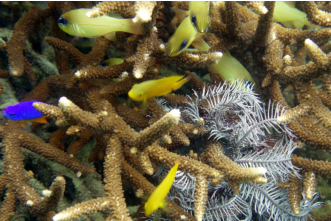
Welcome
We flew 2 hours north from Darwin to Biak in West Papua and set off on an amazing expedition aboard Coral Discoverer to explore life in and around the waters of Raja Ampat and the Spice Islands. The scenery is so unspoilt and colourful that they seem like something in a fairy story. There are many tiny islands covered by bright green trees and ringed by white sands and turquoise seas. Protruding from the turquoise blue waters are many amorphous limestone karsts (sharp stone islands). The number and variety of coral species and colours are truly stunning and the brightly coloured fish come in all sorts of patterns - spots, stripes and crazy prints. I have never seen such beautiful, pristine, colourful underwater scenes. The underwater world more than makes up for the lack of birds and land creatures - we saw very few of the 550 species of bird that inhabit this part of the world and even fewer land creatures. There are no roads, no towns and no harbours – just hundreds of miles of virgin planet Earth Snorkelling with the huge whale sharks, watching 5 giant manta rays swim by whilst diving, admiring the brightly coloured fish and coral, being mesmerised by the beautiful turquoise blue seas and the spectacular scenery makes Raja Ampat a special delight to visit and I feel so lucky to have those wonderful, lasting memories.West Papua
West Papua lies at the heart of the Coral Triangle – the area with the richest marine life on earth. Over 550 species of coral (three quarters of the world’s coral species) and more than 1,400 varieties of reef fish can be found in its four million hectares of protected waters. It is the least populous province of Indonesia and features what many describe as the final frontier in diving terms – diving on untouched, pristine reefs with such an abundance and biodiversity of marine life. It didn’t disappoint!Cenderawasih Bay
Cenderawasih Bay – A marine park with finging reefs, endemic species and unique topography where deep dwelling fish and whale sharks are found in shallow waters. Whale sharks come to breed, giant manta rays swim in the sandy bays and sperm whales gather to feed on plankton swept up from the Antarctic – it’s a snorkelling and diving underwater heaven.Raja Ampat
At the heart of the Coral Triangle, this archipelago of over 1500 small islands has the richest, most colourful fish and critter filled reefs on Earth providing some of the best and most remote snorkelling and diving in the world. There are more than 600 known species of reef coral and over 1400 species of reef fish. Marine Biologists consider the Misool Islands to be the world’s epicentre of marine life. Raja Ampat means Four Kings which represent the main islands of Misool, Salawat, Batanta and Waigeo. There is a population of about 50,000 on the islands. Spice Islands In the middle of the Banda Sea, lies the Banda Islands which were the centre of the spice trade in the 17th century and scene of some of the earliest European ventures in Asia. Originally the world’s sole source of nutmeg and mace, these tiny islands have attracted traders for over 2,000 years.
© Nova Fisher, novatravels.net. Many underwater photos are copyright of fellow travellers, Cory & Gwynn Wiliams

Indonesia
Indonesia, the world’s largest archipelago, lies across the equator stretching from the Asian mainland to Papua New Guinea. Flying from one end to the other - North Sumatra to West Papua - takes over 12 hours. It is the fourth most populous country in the World. These 17,508 islands combine miles of coastline, rich volcanic soil, warm equatorial currents, nutrient rich up-wellings and a tropical climate that together create a biological wonderland.

Papuan Tribes
The Islanders aren’t that different from the tribes that Wallace encountered in the 1860s – fishermen and fruit-gatherers, paddling dugout canoes, their features a mix of Aboriginal, Melanesian and Malaysian. Cannibalism and headhunting were regularly encountered until the 1970’s. The most populated tribe that live in Raja Ampat are Asmat people. Their societies are Muslims and Christians, and often within a family or clan members have different beliefs which make them keep on living in harmony. More than 200 languages are still spoken by the various tribes of West Papua, many of which have only recently made contact with the outside world.
Click on any
photo to see a
larger version



























